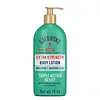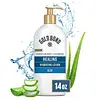What's inside
What's inside
 Key Ingredients
Key Ingredients

 Benefits
Benefits

 Concerns
Concerns

 Ingredients Side-by-side
Ingredients Side-by-side

Menthol 0.5%
MaskingWater
Skin ConditioningGlycerin
HumectantPetrolatum
EmollientAloe Barbadensis Leaf Juice
Skin ConditioningCetyl Alcohol
EmollientStearyl Alcohol
EmollientPropylene Glycol
HumectantDimethicone
EmollientStearamidopropyl Pg-Dimonium Chloride Phosphate
Distearyldimonium Chloride
Cetearyl Alcohol
EmollientSteareth-21
CleansingTocopheryl Acetate
AntioxidantPolysorbate 60
EmulsifyingHydroxyacetophenone
AntioxidantSteareth-2
EmulsifyingParfum
MaskingEDTA
Niacinamide
Smoothing3-O-Ethyl Ascorbic Acid
Skin ConditioningPotassium Hydroxide
BufferingCitric Acid
BufferingMenthol 0.5%, Water, Glycerin, Petrolatum, Aloe Barbadensis Leaf Juice, Cetyl Alcohol, Stearyl Alcohol, Propylene Glycol, Dimethicone, Stearamidopropyl Pg-Dimonium Chloride Phosphate, Distearyldimonium Chloride, Cetearyl Alcohol, Steareth-21, Tocopheryl Acetate, Polysorbate 60, Hydroxyacetophenone, Steareth-2, Parfum, EDTA, Niacinamide, 3-O-Ethyl Ascorbic Acid, Potassium Hydroxide, Citric Acid
Water
Skin ConditioningGlycerin
HumectantPetrolatum
EmollientJojoba Esters
EmollientCetyl Alcohol
EmollientAloe Barbadensis Leaf Juice
Skin ConditioningStearyl Alcohol
EmollientDistearyldimonium Chloride
Cetearyl Alcohol
EmollientSteareth-2
EmulsifyingSteareth-21
CleansingPropylene Glycol
HumectantChamomilla Recutita Flower Extract
MaskingPolysorbate 60
EmulsifyingStearamidopropyl Pg-Dimonium Chloride Phosphate
Methyl Gluceth-20
HumectantTocopheryl Acetate
AntioxidantMagnesium Ascorbyl Phosphate
AntioxidantHydrolyzed Collagen
EmollientHydrolyzed Elastin
EmollientRetinyl Palmitate
Skin ConditioningHydrolyzed Jojoba Esters
Skin ConditioningGlyceryl Stearate
EmollientEDTA
Parfum
MaskingPotassium Hydroxide
BufferingDiazolidinyl Urea
PreservativeMethylparaben
PreservativeWater, Glycerin, Petrolatum, Jojoba Esters, Cetyl Alcohol, Aloe Barbadensis Leaf Juice, Stearyl Alcohol, Distearyldimonium Chloride, Cetearyl Alcohol, Steareth-2, Steareth-21, Propylene Glycol, Chamomilla Recutita Flower Extract, Polysorbate 60, Stearamidopropyl Pg-Dimonium Chloride Phosphate, Methyl Gluceth-20, Tocopheryl Acetate, Magnesium Ascorbyl Phosphate, Hydrolyzed Collagen, Hydrolyzed Elastin, Retinyl Palmitate, Hydrolyzed Jojoba Esters, Glyceryl Stearate, EDTA, Parfum, Potassium Hydroxide, Diazolidinyl Urea, Methylparaben
Ingredients Explained
These ingredients are found in both products.
Ingredients higher up in an ingredient list are typically present in a larger amount.
Aloe Barbadensis Leaf Juice comes from leaves of the aloe plant. Aloe Barbadensis Leaf Juice is best known for helping to soothe sunburns. It is also anti-inflammatory, moisturizing, antiseptic, and can help heal wounds.
Aloe is packed with good stuff including Vitamins A, C, and E. These vitamins are antioxidants, which help fight free-radicals and the damage they may cause. Free-radicals are molecules that may damage your skin cells, such as pollution.
Aloe Barbadensis Leaf Juice also contains sugars. These sugars come in the form of monosaccharides and polysaccharides, folic acid, and choline. These sugars are able to help bind moisture to skin.
It also contains minerals such as calcium, 12 anthraquinones, fatty acids, amino acids, and Vitamin B12.
Learn more about Aloe Barbadensis Leaf JuiceCetearyl alcohol is a mixture of two fatty alcohols: cetyl alcohol and stearyl alcohol. It is mainly used as an emulsifier. Emulsifiers help prevent the separation of oils and products. Due to its composition, it can also be used to thicken a product or help create foam.
Cetearyl alcohol is an emollient. Emollients help soothe and hydrate the skin by trapping moisture.
Studies show Cetearyl alcohol is non-toxic and non-irritating. The FDA allows products labeled "alcohol-free" to have fatty alcohols.
This ingredient is usually derived from plant oils such as palm, vegetable, or coconut oils. There is debate on whether this ingredient will cause acne.
Due to the fatty acid base, this ingredient may not be Malassezia folliculitis safe.
Learn more about Cetearyl AlcoholCetyl Alcohol is a fatty alcohol. Fatty Alcohols are most often used as an emollient or to thicken a product.
Its main roles are:
Though it has "alcohol" in the name, it is not related to denatured alcohol or ethyl alcohol.
The FDA allows products labeled "alcohol-free" to have fatty alcohols.
Learn more about Cetyl AlcoholWe don't have a description for Distearyldimonium Chloride yet.
EDTA is the shortened name for ethylenediamine tetraacetic acid. It is a chelating agent and used to stabilize products.
Chelating Agents are used to prevent trace metal ions from binding to other ingredients. This can prevent unwanted reactions or changed efficacy of products.
Glycerin is already naturally found in your skin. It helps moisturize and protect your skin.
A study from 2016 found glycerin to be more effective as a humectant than AHAs and hyaluronic acid.
As a humectant, it helps the skin stay hydrated by pulling moisture to your skin. The low molecular weight of glycerin allows it to pull moisture into the deeper layers of your skin.
Hydrated skin improves your skin barrier; Your skin barrier helps protect against irritants and bacteria.
Glycerin has also been found to have antimicrobial and antiviral properties. Due to these properties, glycerin is often used in wound and burn treatments.
In cosmetics, glycerin is usually derived from plants such as soybean or palm. However, it can also be sourced from animals, such as tallow or animal fat.
This ingredient is organic, colorless, odorless, and non-toxic.
Glycerin is the name for this ingredient in American English. British English uses Glycerol/Glycerine.
Learn more about GlycerinParfum is a catch-all term for an ingredient or more that is used to give a scent to products.
Also called "fragrance", this ingredient can be a blend of hundreds of chemicals or plant oils. This means every product with "fragrance" or "parfum" in the ingredients list is a different mixture.
For instance, Habanolide is a proprietary trade name for a specific aroma chemical. When used as a fragrance ingredient in cosmetics, most aroma chemicals fall under the broad labeling category of “FRAGRANCE” or “PARFUM” according to EU and US regulations.
The term 'parfum' or 'fragrance' is not regulated in many countries. In many cases, it is up to the brand to define this term.
For instance, many brands choose to label themselves as "fragrance-free" because they are not using synthetic fragrances. However, their products may still contain ingredients such as essential oils that are considered a fragrance by INCI standards.
One example is Calendula flower extract. Calendula is an essential oil that still imparts a scent or 'fragrance'.
Depending on the blend, the ingredients in the mixture can cause allergies and sensitivities on the skin. Some ingredients that are known EU allergens include linalool and citronellol.
Parfum can also be used to mask or cover an unpleasant scent.
The bottom line is: not all fragrances/parfum/ingredients are created equally. If you are worried about fragrances, we recommend taking a closer look at an ingredient. And of course, we always recommend speaking with a professional.
Learn more about ParfumPetrolatum is more commonly known as petroleum jelly. It is created by mixing waxes and mineral oils.
This ingredient is effective at reducing water loss by 99%. This is because it is an occlusive. Occlusives create a hydrophobic barrier on the skin to prevent evaporation. This property makes it great for hydrating dry skin.
Pro tip: Use occlusives, such as this ingredient, on damp skin for the best results.
The quality or origin of petrolatum is only known when disclosed by the brand. Most cosmetic petrolatum has gone through several purification stages.
Another benefit of occlusives is it protects your skin against infection or allergies.
Petrolatum may not be safe for fungal-acne. Studies show mineral oil / petroleum leads to the growth of M. Furfur, a type of yeast.
Learn more about PetrolatumPolysorbate 60 is used to help stabilize products. It is a surfactant and emulsifier. These properties help keep ingredients together in a product. Surfactants help reduce surface tension between ingredients with different states, such as liquids and solids. Emulsifiers help prevent oils and waters from separating.
Polysorbate 60 is sorbitol-based and created from the ethoxylation of sorbitan. Ethoxylation is a chemical reaction used to add ethylene oxide. Sorbitan is a the dehydrated version of sorbitol, a sugar found in fruits.
In this case, the 60 comes from reacting 60 units of ethylene oxide with sorbitan.
Polysorbates are commonly used in medicine and foods.
Learn more about Polysorbate 60Potassium hydroxide is commonly known as caustic potash. It is used to fix the pH of a product or as a cleaning agent in soap. In cleansers, it is used for the saponification of oils.
Sapnification is the process of creating fatty acid metal salts from triglycerides and a strong base. During this process, Potassium Hydroxide is used up and is not present in the final product.
Using high concentrations of Potassium Hydroxide have shown to irritate the skin.
Learn more about Potassium HydroxidePropylene Glycol is an odorless, colorless liquid. As a humectant, it helps skin retain moisture. It also aids in delivering active ingredients.
Another role of this ingredient is preventing a product from melting or freezing. Propylene glycol also adds antimicrobrial properties to a product, elongating product lifespan.
This ingredient is considered an organic alcohol and commonly added into both cosmetics and foods.
Those with sensitive skin or conditions may develop a rash when using this ingredient.
Learn more about Propylene GlycolWe don't have a description for Stearamidopropyl Pg-Dimonium Chloride Phosphate yet.
Steareth-2 is a waxy compound used to emulsify ingredients. It is created from polyethylene glycol and stearyl alcohol.
The 2 stands for the number of ethylene oxide units used to create this ingredient.
We don't have a description for Steareth-21 yet.
Stearyl Alcohol is a type of fatty alcohol from stearic acid. It is a white, waxy compound used to emulsify ingredients.
Fatty Alcohols are most often used as an emollient or to thicken a product. Emollients help soothe and hydrate the skin by trapping moisture.
They are usually derived from natural fats and oils and therefore do not have the same drying or irritating effect as solvent alcohols. FDA allows products labeled "alcohol-free" to have fatty alcohols.
Learn more about Stearyl AlcoholTocopheryl Acetate is AKA Vitamin E. It is an antioxidant and protects your skin from free radicals. Free radicals damage the skin by breaking down collagen.
One study found using Tocopheryl Acetate with Vitamin C decreased the number of sunburned cells.
Tocopheryl Acetate is commonly found in both skincare and dietary supplements.
Learn more about Tocopheryl AcetateWater. It's the most common cosmetic ingredient of all. You'll usually see it at the top of ingredient lists, meaning that it makes up the largest part of the product.
So why is it so popular? Water most often acts as a solvent - this means that it helps dissolve other ingredients into the formulation.
You'll also recognize water as that liquid we all need to stay alive. If you see this, drink a glass of water. Stay hydrated!
Learn more about Water